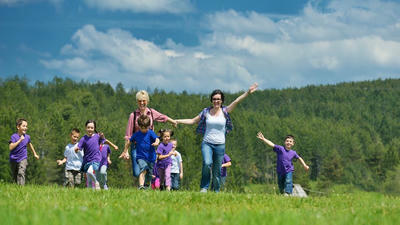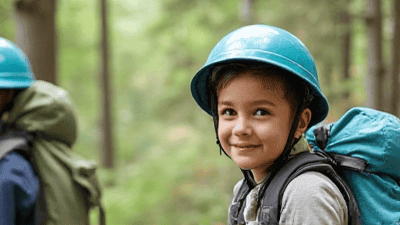
In an era where technology dominates our lives, outdoor education is making a resurgence in schools and learning environments. It emphasizes experiential learning outside the traditional classroom setting, focusing on nature, teamwork, and hands-on experiences. Research indicates that outdoor education plays a crucial role in promoting student well-being, leading to enhanced physical health, emotional resilience, social skills, and academic performance.
Understanding Outdoor Education
Outdoor education encompasses various activities and experiences conducted in natural environments. It ranges from organized field trips and camping excursions to environmental studies and adventure-based learning. The primary goal of outdoor education is to connect students with nature while developing critical life skills such as teamwork, leadership, and problem-solving.
These programs often integrate academic content with hands-on learning, allowing students to apply classroom knowledge in real-world contexts. Outdoor education is not limited to a specific age group; it can benefit students of all ages, from elementary school children to high school students and even adults involved in professional development.
The Connection Between Nature and Well-Being
Before delving into the specific impacts of outdoor education on student well-being, it is essential to recognize the broader context of nature and its relation to human health. Numerous studies have indicated that spending time in natural settings can lead to various psychological and physical benefits.
1. Stress Reduction
Exposure to nature has been linked to reduced levels of cortisol, the hormone associated with stress. Natural environments promote relaxation, which helps alleviate anxiety and tension. For students facing academic pressures, outdoor education can serve as a restorative experience, allowing them to recharge and return to their studies with renewed focus.
2. Improved Mood
Engaging with nature positively influences mood and emotional well-being. Activities in natural settings can increase feelings of happiness and fulfillment. Studies have shown that children who spend time outdoors exhibit fewer signs of depression and anxiety, contributing to overall mental health.
3. Enhanced Physical Health
Outdoor education often involves physical activity, which benefits both physical and mental health. Regular exercise is crucial for maintaining a healthy lifestyle, and outdoor education promotes active involvement in fun activities like hiking, climbing, and team sports. This physical engagement improves cardiovascular health, boosts immunity, and enhances overall well-being.
The Impact of Outdoor Education on Student Well-Being
1. Physical Health Benefits
The physical health benefits of outdoor education can be particularly impactful for students. Many children today experience sedentary lifestyles, primarily due to excessive screen time and limited outdoor play. Outdoor education encourages students to engage in physical activities that boost fitness levels.
-
Increased Activity Levels: Outdoor education programs often incorporate various physical activities that encourage students to move more than traditional classrooms allow. This increased activity can contribute to a decrease in obesity rates and related health issues.
-
Enhanced Motor Skills: Outdoor education provides opportunities for students to develop fine and gross motor skills through activities such as climbing, running, and navigating through challenging terrains.
-
Connection to Healthy Living: Engaging with nature reinforces the importance of a healthy lifestyle. Outdoor education can instill a lifelong appreciation for physical activity and healthy living habits.
2. Emotional Resilience and Mental Health
Outdoor education significantly contributes to the emotional resilience of students. Here are several ways it promotes mental health:
-
Increased Self-Confidence: Outdoor education often includes challenges that require students to step outside their comfort zones. Whether it is hiking up a steep trail or conquering a climbing wall, overcoming these challenges fosters self-confidence and self-efficacy.
-
Mindfulness and Reflection: Time spent in nature encourages mindfulness, where students can reflect on their thoughts and feelings in a calming environment. This practice enhances emotional regulation and coping mechanisms.
-
Developing Coping Strategies: Outdoor education can help students develop coping strategies to handle stress and adversity. Experiencing and navigating challenges in nature teaches them resilience and adaptability.
3. Social Skills Development
Outdoor education provides numerous opportunities for students to develop essential social skills as they learn and work together in natural settings. Collaborative activities are designed to foster teamwork, communication, and effective problem-solving.
-
Team Building: Many outdoor activities require students to collaborate closely, promoting teamwork. Activities such as group challenges and team sports teach students the importance of working together towards common goals.
-
Improved Communication: Being in an outdoor environment encourages open dialogue and cooperation. Students learn to express their ideas and listen actively to their peers, enhancing their communication skills.
-
Conflict Resolution: Working together in challenging situations can lead to conflicts. Outdoor education teaches students how to resolve disputes amicably, developing their ability to manage interpersonal relationships.
4. Academic Engagement and Achievement
The integration of outdoor education into the curriculum has a positive impact on academic engagement and achievement. The hands-on learning experiences offered in natural settings often lead to improved retention and understanding of academic content.
-
Experiential Learning: Outdoor education transforms abstract concepts into tangible experiences. For example, studying ecosystems outside the classroom allows students to engage with the material on a deeper level, leading to better comprehension.
-
Increased Motivation: The dynamic nature of outdoor education captivates students' interests. When learning takes place in an engaging, interactive environment, students are more likely to be motivated and enthusiastic about their studies.
-
Real-World Application: Outdoor education helps students see the real-world relevance of what they learn. Whether it involves studying geology on a field trip or understanding biology through nature walks, students can connect their learning to tangible experiences.
5. Fostering Environmental Awareness
Outdoor education inherently promotes environmental stewardship and awareness among students. By spending time in nature, students develop an appreciation for the environment and an understanding of ecological principles.
-
Connection to Nature: Experiencing nature firsthand helps students develop a sense of belonging to the ecosystem. This connection fosters environmental ethics, leading them to become responsible stewards of the planet.
-
Informed Decision-Making: Education centered around environmental issues helps students make informed choices regarding sustainability. They become more aware of the impacts of their actions on the environment and can advocate for positive change.
-
Skill Development for Future Challenges: As students learn about environmental challenges such as climate change and conservation, they acquire the knowledge and skills needed to address these issues in the future.

Implementing Outdoor Education Programs
To harness the benefits of outdoor education, schools must take proactive steps to incorporate it into their curricula. Here are some effective strategies for implementing outdoor education programs:
1. Curriculum Integration
Outdoor education should be integrated into the existing curriculum rather than treated as an isolated subject. Educators can develop lesson plans that incorporate outdoor experiences to reinforce academic content. For example, science classes can involve hands-on experiments in natural settings, while literature classes can include nature-based storytelling.
2. Collaboration with Community Organizations
Schools should seek partnerships with local environmental organizations, nature centers, and outdoor education providers. These collaborations can enrich the educational experience by providing resources, expertise, and potential funding for outdoor programs.
3. Training for Educators
Professional development is essential for educators looking to implement outdoor education effectively. Training programs can equip teachers with the skills needed to facilitate outdoor activities, address safety concerns, and connect curriculum content to outdoor experiences.
4. Community Involvement
Encouraging parents and community members to participate in outdoor education activities fosters a sense of shared responsibility for student learning. Organizing family outdoor events and inviting community experts to lead activities can enhance students' experiences.
5. Providing Access to Natural Spaces
Schools should seek to maximize access to natural spaces for outdoor education. Whether it involves utilizing schoolyards, local parks, or nature reserves, having easy access to outdoor environments is essential for effective programming.
Challenges and Considerations
While outdoor education offers numerous benefits, schools must also consider potential challenges and barriers to implementation:
1. Safety Concerns
Safety is a primary concern when conducting outdoor activities. Educators must ensure that outdoor settings are safe and equip students with the necessary skills to navigate potentially challenging environments.
2. Time Constraints
Integrating outdoor education into the curriculum may require adjustments to existing schedules. Educators must balance academic demands while creating opportunities for outdoor learning.
3. Accessibility Issues
Not all students may have equal access to outdoor education experiences, particularly those with disabilities. Schools should strive to ensure inclusivity by adapting activities and providing necessary accommodations.
4. Weather Conditions
Weather can pose a significant challenge in outdoor education. Educators need to plan for contingencies and have alternative indoor activities ready, ensuring that learning continues regardless of external conditions.
Conclusion
The impact of outdoor education on student well-being is profound and far-reaching. By engaging with nature, students experience numerous benefits related to physical health, emotional resilience, social skills development, and academic achievement. As educators seek innovative methods to enhance student learning experiences, outdoor education emerges as a powerful tool.
Incorporating outdoor education into the curriculum requires commitment and creativity, but the rewards are well worth the effort. By fostering a love for nature, encouraging exploration, and providing opportunities for growth, outdoor education has the potential to shape the future of education while promoting holistic student well-being.



